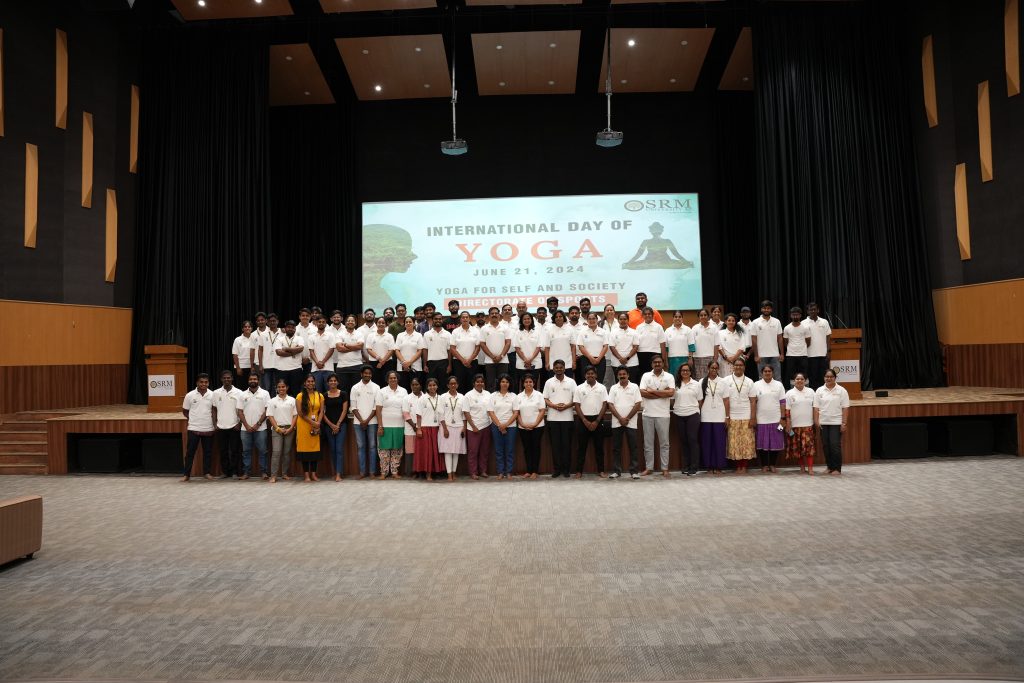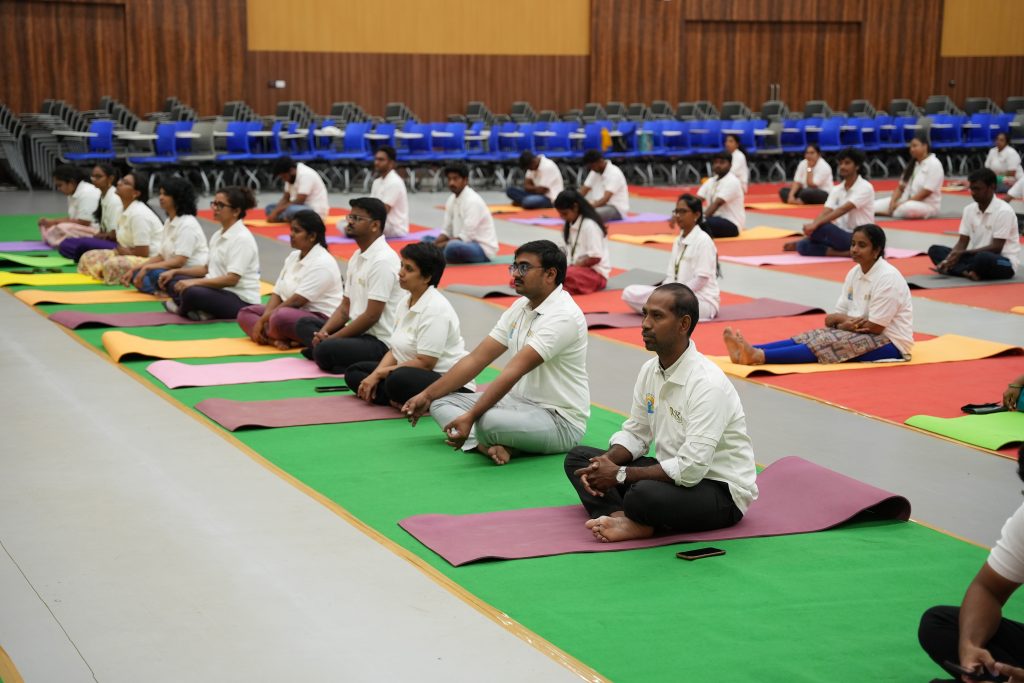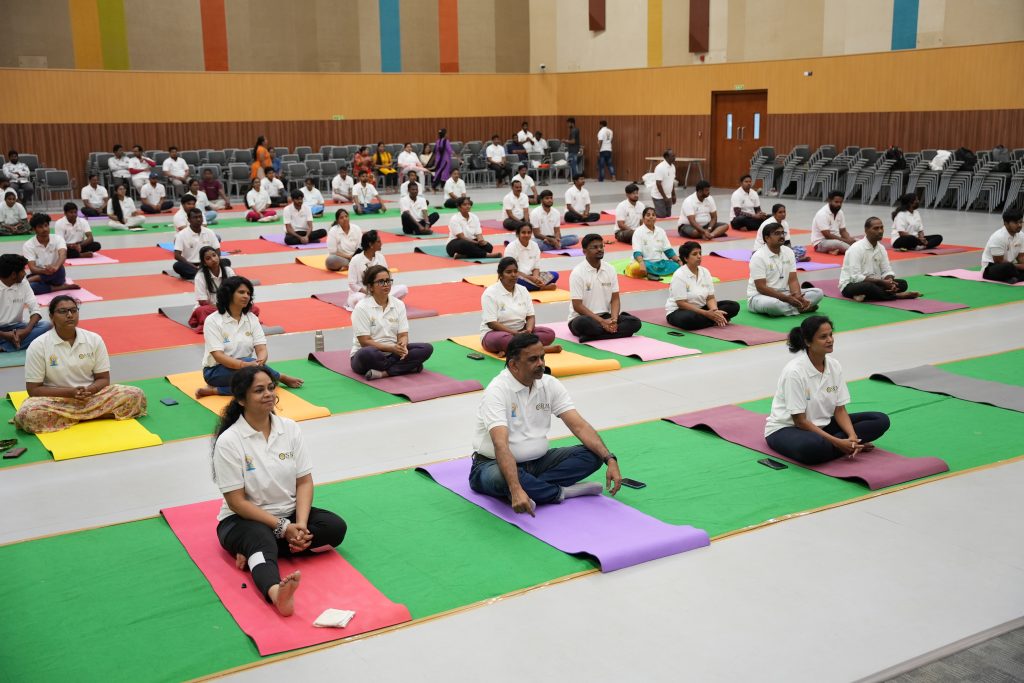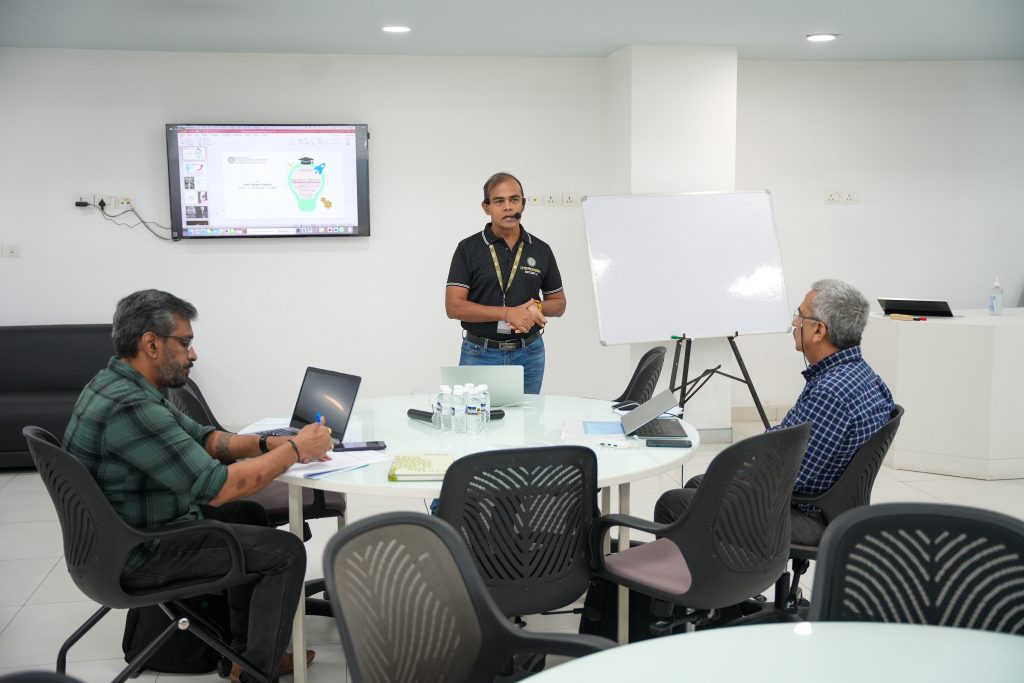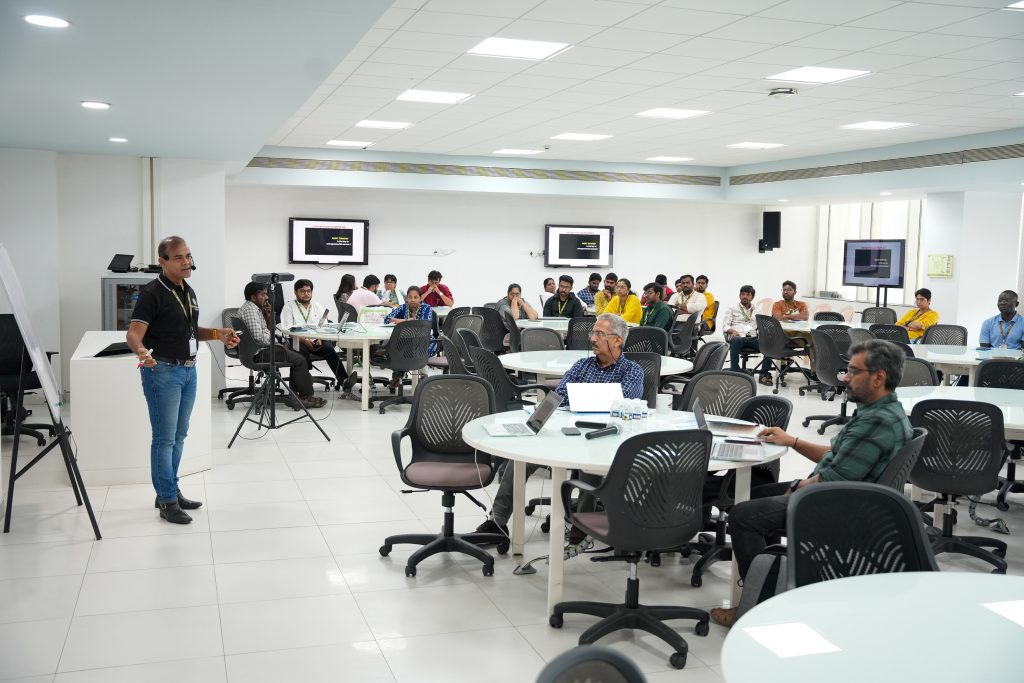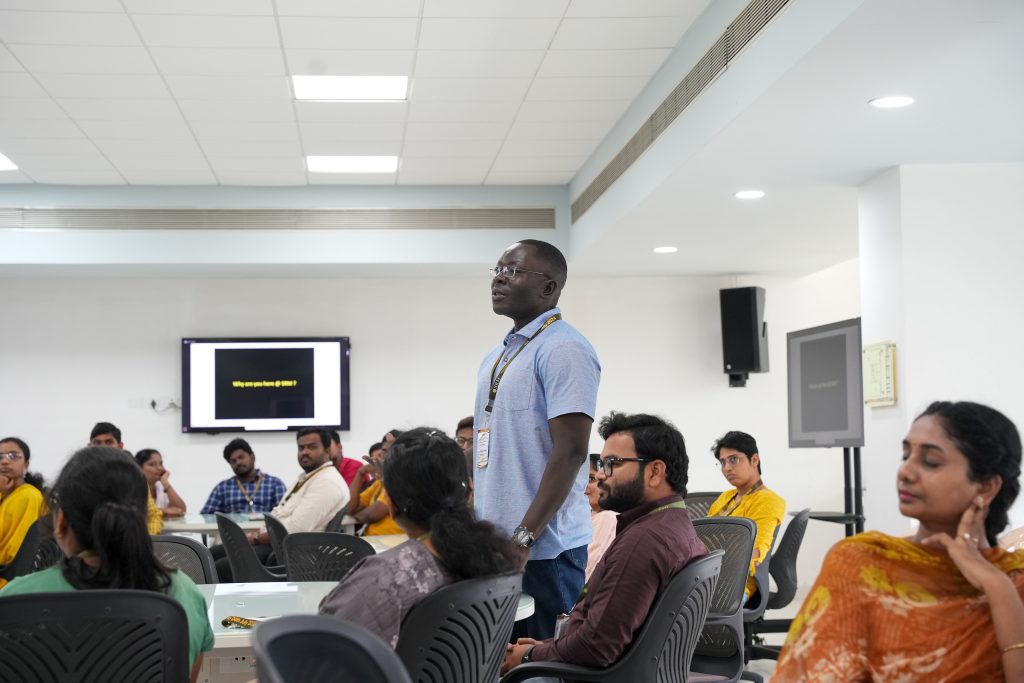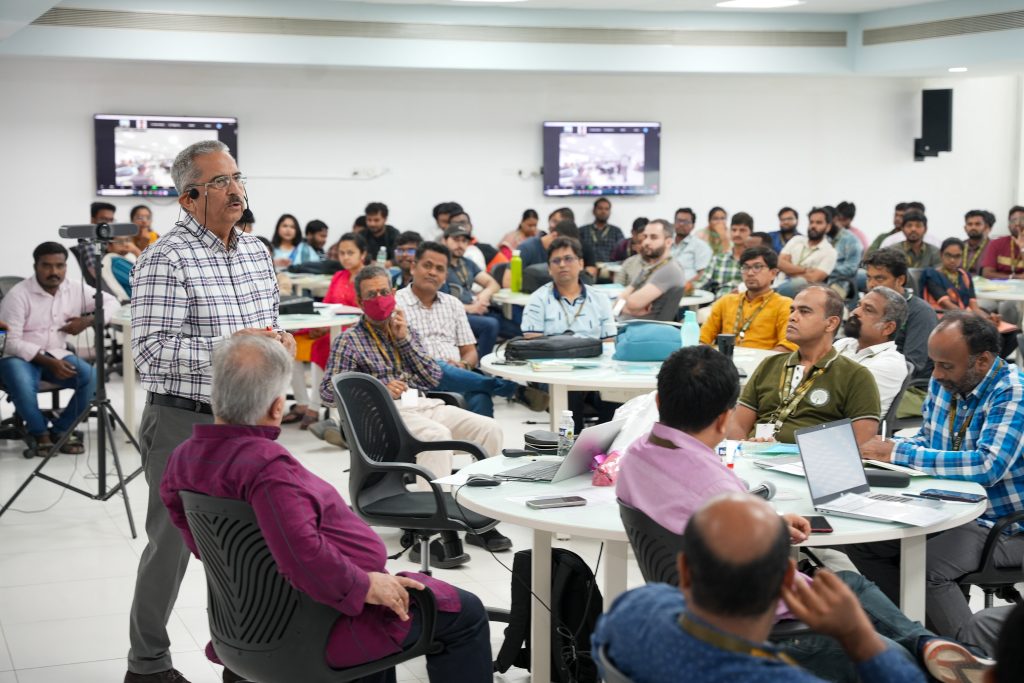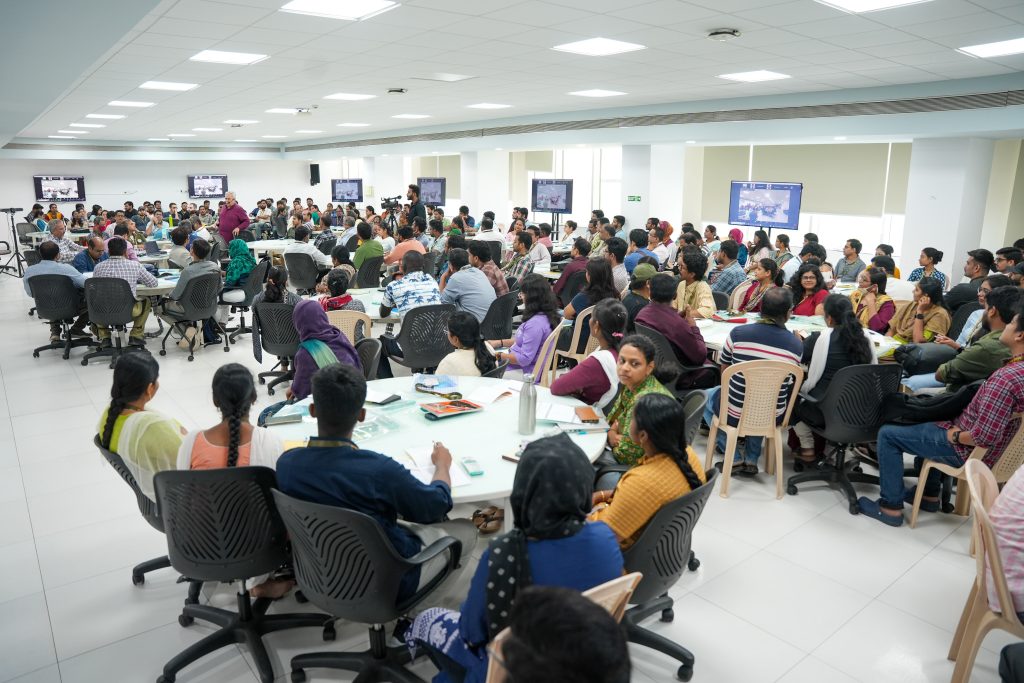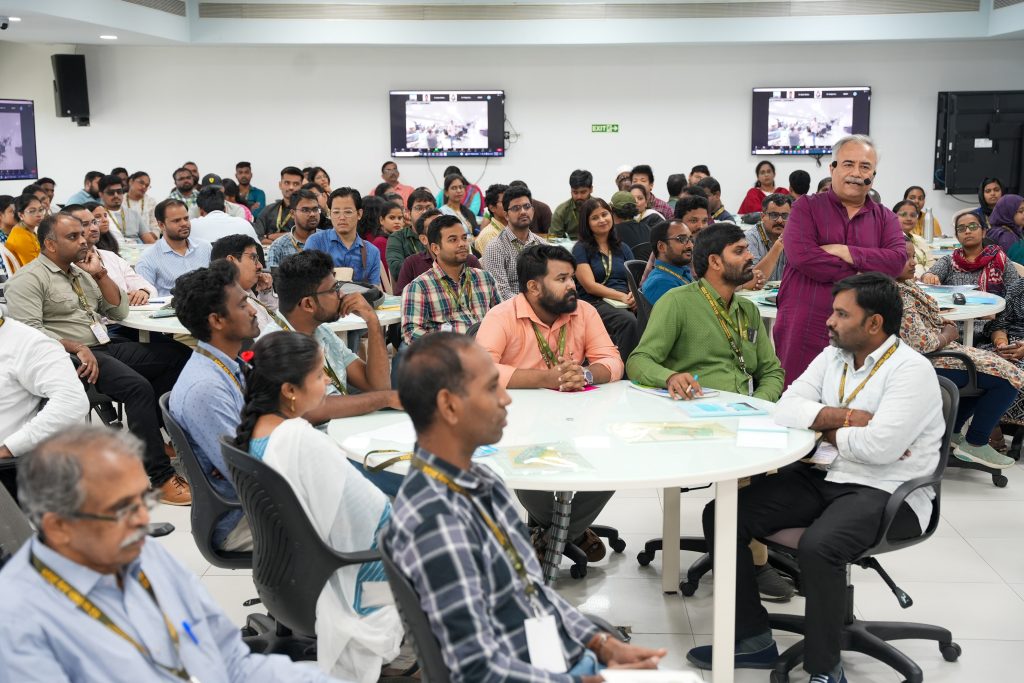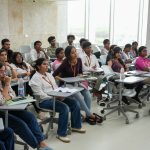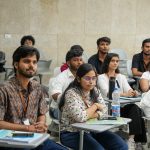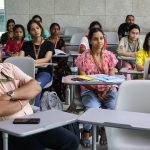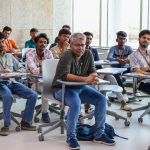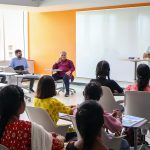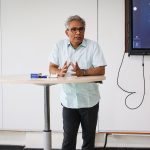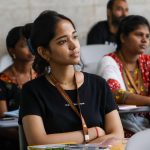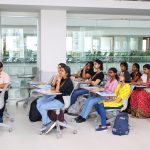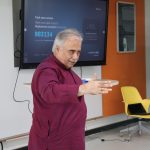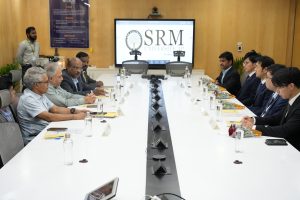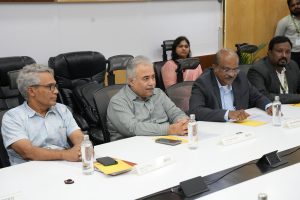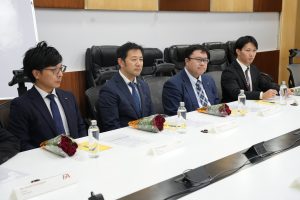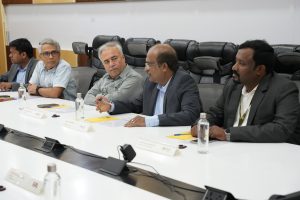SRM-AP All News
ALL News
- Research to Revenue: 3-day Workshop Concludes July 9, 2024
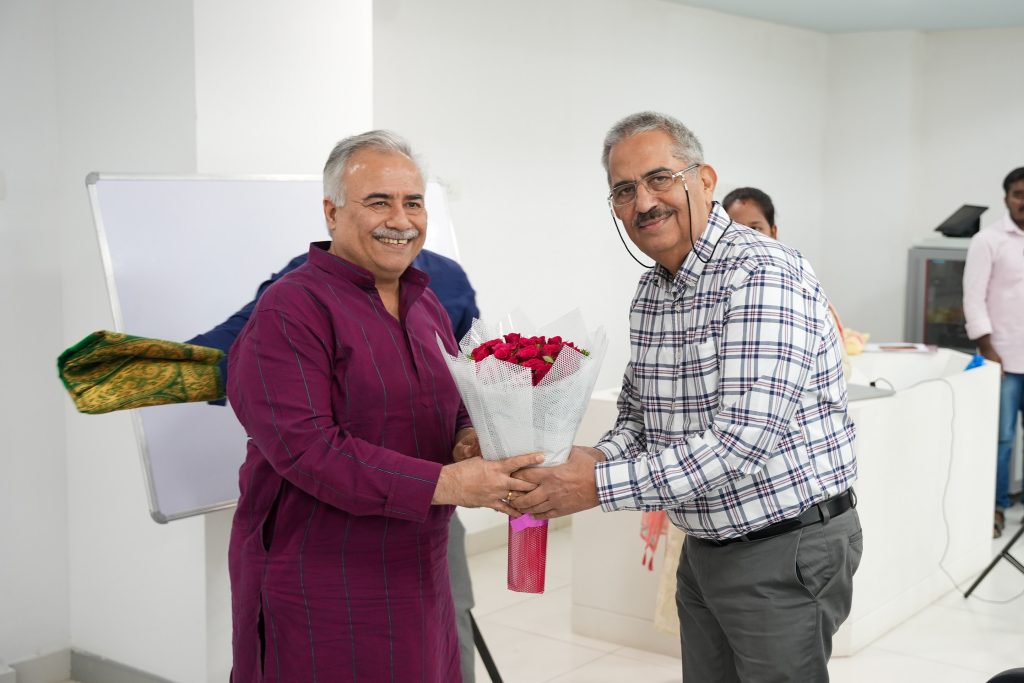 The Office of the Dean-Research and IPR Cell at SRM University-AP hosted a highly impactful 3-day Workshop on “Research Commercialisation.” The workshop was graced by industry expert Mr Rakesh Sharma, a leading figure in business restructuring and global marketing. Mr Sharma with his notable experience of 38 years at Philips, imparted valuable insights on innovation, venture development, and commercialisation.
The Office of the Dean-Research and IPR Cell at SRM University-AP hosted a highly impactful 3-day Workshop on “Research Commercialisation.” The workshop was graced by industry expert Mr Rakesh Sharma, a leading figure in business restructuring and global marketing. Mr Sharma with his notable experience of 38 years at Philips, imparted valuable insights on innovation, venture development, and commercialisation.The workshop was attended by faculty and research scholars, all keen on understanding the intricacies of research commercialisation. The inaugural ceremony of the workshop was highlighted by the felicitation of Mr Sharma by the Vice Chancellor, Prof. Manoj K Arora, along with Prof. Ranjit Thapa, Dean—Research; Deans of the three schools; Prof. G S Vinodkumar, Coordinator—IPR Cell & Convenor of this workshop; and other senior faculty members.
In his address, Prof. Manoj K Arora underscored the critical role of research, he urged the attendees to “think differently and change your mindset to unlock the boundless potential of your research and innovation.” He engaged with faculty and research scholars, seeking their perspectives. Prof. Ranjith Thapa, the Dean of Research, presented an overview of the varsity’s research capabilities, spotlighting its achievements in Q1 publications and patents across different departments.
Day 1– The workshop kicked off with Mr Sharma encouraging participants to voice their queries and concerns about commercialisation. Key discussion points covered included linking university research with practical applications, the transformation of patents and research into industry-ready products, understanding market needs, fundraising for research projects, and leveraging humanities and liberal arts in patent implementation. Mr Sharma engaged with each of the queries and closely explained to the students with simple and easy-to-understand examples, thereby making the session worthwhile and interesting.
Day 2—Scholars had the opportunity to present their published and granted patents. They received constructive feedback from faculty and Mr Sharma and understood how these patents could be further developed for commercialisation, thereby leading to fruitful discussions on improving and materialising these ideas.
Day 3– A significant outcome of the workshop was the proposal to establish a new centre for research commercialisation designed to offer students an in-house pathway to commercialise their patents. This initiative received widespread acclaim from all participants and sparked engaging discussions about transforming research into viable business ventures, facilitated by the session by the Director of Entrepreneurship and Innovation, Mr Sidharth Shankar Tripathy.
The workshop offered a crucial platform for students, offering both inspiration and guidance in their pursuit of entrepreneurship. The event was specifically designed for all PhD Scholars who are currently working on their research papers and looking for ways to commercialise their innovative ideas, projects, or inventions.
Through a series of expert-led sessions, interactive discussions, and networking opportunities, students were encouraged to think critically about their project’s potential impact, market readiness, and the pathways to achieving sustainable business growth.
Continue reading → - MOU with ASPIRE BioNEST, UoH for Augmenting Innovation and Incubation July 8, 2024
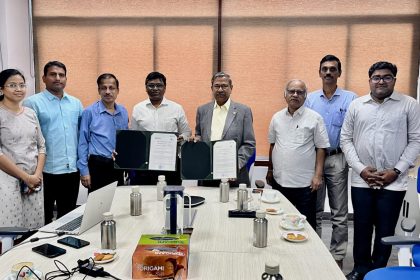
SRM University-AP signs an MOU with the Association for Scientific Pursuits in Innovative Research BioNEST (ASPIRE BioNEST) of the University of Hyderabad, facilitating a dynamic transformation in the innovation and entrepreneurial ecosystem of the institute. Prof. S Rajagopal, Director ASPIRE BioNEST and Dr R Premkumar, Registrar, SRM University-AP signed the MOU in the presence of Dr Anil Kondreddy, COO, ASPIRE BioNEST, Prof. Jayaseelan Murugaiyan, Associate Dean-Sciences, SRM University-AP and Dr Pitchaiah Cherukuri, Assistant Professor, SRM University-AP.
The agreement will ensure guidance and support from ASPIRE BioNEST in establishing, operating and maintaining the best innovation and incubation practices at the SRM AP incubation centres. ASPIRE BioNEST will also provide support in selection of incubates/start-ups, finalising facilities/designs, procurement of instruments and help in formulating guidelines and policies for operating incubation centres at the university.
The MOU is a significant milestone for the young innovators and venturers at SRM AP as ASPIRE BioNEST will furnish internship opportunities with incubatees and startups at ASPIRE, mentor support for startups, collaboration in applying for grant proposals and raising funds, and training and skill development programmes.
Vice Chancellor, Prof. Manoj K Arora expressed his ardour on the collaboration. He stated that “ASPIRE BioNEST is one of the Best Bio-incubator where most of the innovative research is translated into technologies. As an institute that prioritise innovation and entrepreneurship, this MOU will stimulate and enrich SRM University-AP’s entrepreneurial culture, helping us to become one of the preferred incubation and innovation centres in Andhra Pradesh.”
ASPIRE BioNEST of the University of Hyderabad is a deep-tech life sciences incubator established in 2018 with the support of BIRAC, Government of India and ASPIRE, a section 8 non-profit company established by University of Hyderabad. One of the key objectives of ASPIRE BioNEST is to provide support and guidance, including technological, professional and collaborative inputs to help other incubation centres raise their entrepreneurial culture. With the agreement, both SRM University-AP and ASPIRE BioNEST have undertaken to synergistically support each other in the larger interest of innovation and entrepreneurship.
Continue reading → - CSE Academic Innovators File Patent for AI-Powered Refrigeration System July 8, 2024
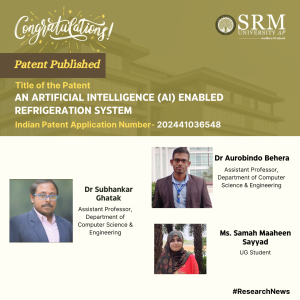 In a significant development for the field of artificial intelligence and sustainable technologies, Dr Subhankar Ghatak, Dr Aurobindo Behera, Assistant Professor, and Ms Samah Maaheen Sayyad, an undergraduate student from the Department of Computer Science and Engineering, have collectively filed a patent for an “Artificial Intelligence (AI) Enabled Refrigeration System.” The patent, bearing the Application Number 202441036548, has been officially published in the Patent Office Journal, marking a milestone in their academic and research careers.
In a significant development for the field of artificial intelligence and sustainable technologies, Dr Subhankar Ghatak, Dr Aurobindo Behera, Assistant Professor, and Ms Samah Maaheen Sayyad, an undergraduate student from the Department of Computer Science and Engineering, have collectively filed a patent for an “Artificial Intelligence (AI) Enabled Refrigeration System.” The patent, bearing the Application Number 202441036548, has been officially published in the Patent Office Journal, marking a milestone in their academic and research careers.
This innovative refrigeration system promises to enhance efficiency and reduce energy consumption, potentially revolutionising the way we preserve food and other perishables. The team’s dedication to integrating AI into practical applications is a testament to their commitment to advancing technology for the betterment of society. The academic community and industry experts alike are eagerly anticipating further details on the implementation and impact of this patented technology.Abstract
The invention is an advanced smart and AI-enabled refrigerator that seamlessly integrates device and software components. Key features include automatic quantity detection, a reminder system, a spoiler alert system, an inbuilt voice system, an inbuilt barcode scanner, an emotion detection system, and a personalised recipe recommendation system based on user preferences, weather conditions, season, location, and precise quantity measurements.Research in Layperson’s Terms
The invention represents a groundbreaking improvement in traditional refrigerators, providing a new and enriched user experience through AI integration. It addresses food management, user interaction, and personalised recipe recommendations, incorporating user preferences, weather considerations, seasonal variations, location-specific nuances, and accurate quantity measurements.Practical implementation and the social implications associated with it
The practical implementation of the “AN ARTIFICIAL INTELLIGENCE (AI) ENABLED REFRIGERATION SYSTEM ” involves the seamless integration of advanced hardware and sophisticated AI algorithms to create an intelligent and user-friendly refrigerator. The following steps outline the practical implementation:
Hardware Integration:
Sensors: Install advanced sensors, including thermistors for temperature, humidity sensors, barcode scanners, ultrasonic quantity measurement sensors, cameras, spoilage identification sensors, level sensors, defrost sensors, and weight sensors within the refrigerator compartments.
Voice and Emotion Detection Modules: Incorporate a microphone and speaker system for voice interaction and integrate cameras and emotion analysis algorithms for facial recognition and emotion detection.
Connectivity Components: Equip the refrigerator with Wi-Fi or Bluetooth modules to enable seamless data transfer and communication with other smart devices.
Processor and Memory: Utilize a powerful processor and ample memory to support AI algorithms, data processing, and smooth operation.
Display Panel: Implement an LED or touchscreen display for user interaction, providing real-time information and control over the refrigerator’s functionalities.Software Development:
AI Algorithms: Develop and integrate AI algorithms for automatic quantity detection using computer vision, sentiment analysis for emotion detection, and collaborative filtering for personalised recipe recommendations.
Natural Language Processing (NLP): Implement NLP algorithms to enable the inbuilt voice system to understand and respond to user commands effectively.
Image Recognition Software: Utilize image recognition software to accurately read barcodes and analyse visual data from the integrated cameras.
Connectivity Software: Develop software protocols to ensure reliable wireless communication between the refrigerator and other devices or cloud services.
User Interface Software: Design a user-friendly interface for the display panel, allowing users to interact with and manage refrigerator contents easily.Social Implications:
The “AI Enabled Refrigeration System” invention has several profound social implications:1. Reduction in Food Wastage: The automatic quantity detection, reminder system, and spoilage alert system significantly reduce food wastage by ensuring that users are alerted about unused items and potential spoilage. This contributes to more efficient food management and a reduction in household food waste, addressing a critical global issue.
2. Enhanced Food Safety and Health: By providing real-time alerts about food spoilage and precise quantity measurements, the invention ensures that users consume fresh and safe food. This minimizes health risks associated with consuming spoiled food and promotes overall well-being.
3. Personalized Dietary Support: The personalized recipe recommendation system caters to individual dietary preferences and requirements, promoting healthier eating habits. By suggesting recipes based on user preferences, weather conditions, seasonality, and location, the system encourages balanced and nutritious meal planning.
4. Convenience and Efficiency: The inbuilt voice system, emotion detection, and intuitive user interface enhance the convenience and efficiency of managing refrigerator contents. Users can easily access information, receive reminders, and interact with the refrigerator, making food storage and preparation more streamlined.
5. Technological Advancements: The integration of advanced AI technologies in everyday appliances like refrigerators represents a significant step forward in smart home innovation. This can drive further advancements in the field, encouraging the development of more intelligent and interconnected household devices.
6. Environmental Impact: By promoting efficient food management and reducing wastage, the invention indirectly contributes to environmental sustainability. Less food waste translates to lower carbon footprints and reduced strain on food production resources, aligning with global efforts to combat climate change.
Overall, the “AI Enabled Refrigeration System” invention not only offers practical benefits in terms of food management and user convenience but also holds significant social implications by promoting health, reducing waste, and advancing technological innovation in household appliances.
Future Research Plans
Building on the innovative foundation of the “AN ARTIFICIAL INTELLIGENCE (AI) ENABLED REFRIGERATION SYSTEM, ” future research plans involve enhancing the AI algorithms for even greater accuracy in food quantity detection, spoilage prediction and personalised recipe recommendations. This includes exploring more advanced machine learning techniques and incorporating real-time feedback mechanisms to continuously refine the system’s performance. Additionally, research will focus on integrating the refrigerator with broader smart home ecosystems, allowing for seamless interaction with other smart appliances and IoT devices to create a fully connected kitchen experience. Investigations into more sustainable and energy-efficient sensor technologies will also be pursued to further reduce the environmental footprint of the device. Finally, extensive user studies will be conducted to gather feedback and insights, ensuring that the next iterations of the refrigerator are even more aligned with consumer needs and preferences, ultimately driving widespread adoption and maximising the social benefits of this technology.
Pictures Related to the Research

Fig 1: Schematic Arrangement of various Components for adequate operation of the proposed scheme

Fig 2: Schematic Arrangement of various Components for user interaction
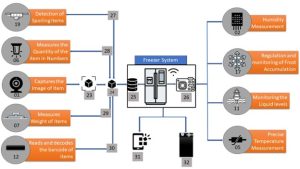
Fig 3: Schematic representation of working of various components in the freezer system
• Pointer Number-27: Spoilage Detection Sensor (19) detects the item that is being spoiled and maps to particular item for alerting the user with the help of the capturing Device (01) and the info associated with that particular item like Expiry date etc.
Continue reading →
• Pointer Number-28: The Ultra Sonic Quantity Measurement Sensor (06) senses the quantity of the ITEM “x” (24), and the camera (01) is used to identify what is ITEM “x” through (23).
• Pointer Number-29: Weight Sensor (07), using newly captured item ITEM “x” (24) by capturing device (01), identifies the weight of that item by subtracting the weight obtained after the addition of that item with the initial holding by the cabinet and attaching the value with corresponding ITEM “x” (24).
• Pointer Number-30: Barcode Scanner (12) scans the Barcode associated with the item and maps the corresponding information with that particular item with the help of the capturing device (01).
• Port Number-31: Mobile Application. - Chetna: Awakening Mathematical Minds July 4, 2024
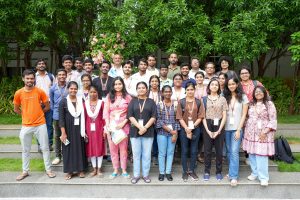 The Department of Mathematics at SRM University-AP successfully conducted a two-week summer programme “Chetna: Awakening Mathematical Minds” from June 17th to June 28th, 2024. This programme aimed to inspire and enhance mathematical understanding among participants from various parts of the country. The programme saw enthusiastic participation from 25 students hailing from different states across India, including West Bengal, Assam, Kerala, Karnataka, Tamil Nadu, Maharashtra, Gujarat, Delhi and Andhra Pradesh.
The Department of Mathematics at SRM University-AP successfully conducted a two-week summer programme “Chetna: Awakening Mathematical Minds” from June 17th to June 28th, 2024. This programme aimed to inspire and enhance mathematical understanding among participants from various parts of the country. The programme saw enthusiastic participation from 25 students hailing from different states across India, including West Bengal, Assam, Kerala, Karnataka, Tamil Nadu, Maharashtra, Gujarat, Delhi and Andhra Pradesh.The programme featured a diverse curriculum, covering a wide range of mathematical topics. Eleven subjects were taught by eleven distinguished faculty members from the Department of Mathematics. The subjects provided a broad and enriching mathematical experience, designed to ignite a passion for mathematics in the participants.
Insights of the Two-Week Programme
First Week Highlights
1. Number Theory by Prof. Kalyan Chakraborty
The first week began with an in-depth exploration of Number Theory. Prof. Kalyan Chakraborty introduced participants to fundamental concepts such as divisibility, prime numbers, and modular arithmetic. The engaging sessions provided a strong foundation in understanding the properties and applications of numbers.2. Abstract Algebra by Dr Anirban Bose
Dr Anirban Bose led the sessions on Abstract Algebra, diving into structures like groups, rings, and fields. The course covered essential algebraic concepts and their applications, enhancing the participants’ problem-solving skills and theoretical knowledge.3. Linear Algebra and Basic Operators by Dr Animesh Bhandari
Dr Animesh’s lectures on Linear Algebra included topics such as vector spaces, linear transformations, and matrices. The sessions aimed to build a solid understanding of linear systems and the role of operators in mathematical computations.4. Graph Theory by Dr Fouzul Atik
Graph Theory, taught by Dr Fouzul Atik, introduced participants to the study of graphs, which are mathematical structures used to model pairwise relations between objects. Topics included graph traversal, connectivity, and graph colouring, providing insights into the practical applications of graph theory.5. Ordinary Differential Equation by Dr Nityananda Roy
The week concluded with Dr Nityananda Roy’s sessions on Ordinary Differential Equations (ODEs). This course covered methods of solving first-order and higher-order ODEs, along with real-world applications of differential equations in various fields.Second Week Highlights
1. Advanced Algebra by Dr Kalyan Banerjee
Building on the first week, this subject delved deeper into algebraic structures, including advanced group theory and ring theory, preparing students for research-level problems.2. Metric Spaces by Dr Choiti Bandyopadhyay
Dr Choiti’s sessions on Metric Spaces introduced participants to the concepts of distance and convergence in metric spaces. Topics included open and closed sets, continuity, and compactness, providing a deeper understanding of analysis.3. Foundations of Probability and Statistics by Dr Vijayakrishna Rowthu
Dr. Vijayakrishna covered the Foundations of Probability and Statistics, focusing on probability theory, random variables, and statistical inference. The course aimed to equip participants with the skills needed to analyze and interpret data.4. Mathematical Modelling by Dr Tapan Kumar Hota
Dr. Tapan’s lectures on Mathematical Modelling demonstrated how mathematics can be used to represent, analyse, and solve real-world problems. The course included case studies and practical applications in various disciplines.5. Partial Differential Equation by Dr Ram Baran Verma
The sessions on Partial Differential Equations (PDEs) by Dr Ram Baran explored methods of solving PDEs and their applications in physics and engineering. Topics included separation of variables, Fourier series, and boundary value problems.6. Math Education by Dr Jayasree Subramanian
The final course on Math Education, taught by Dr Jayasree, focused on pedagogical approaches and techniques for teaching mathematics effectively. The sessions aimed to inspire future educators and enhance their teaching methodologies.Conclusion
Continue reading →
The “Chetna: Awakening Mathematical Minds” summer programme was a resounding success, providing participants with valuable insights and knowledge in mathematics. The diverse backgrounds of the participants and the expertise of the faculty created a vibrant and stimulating learning environment, fostering a deeper appreciation for the subject. The Department of Mathematics at SRM University -AP looks forward to organising similar programmes in the future to continue inspiring young mathematical minds across the country. - SRM AP Signs MoU with Human Resocia to Create Employment Opportunities in Japan for Students July 4, 2024
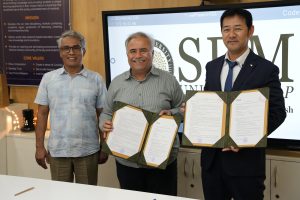 SRM University-AP has signed an MoU with Human Resocia to facilitate employment and job opportunities for university students in Japan. This collaborative agreement partners HR to provide all the necessary facilities required for students to pursue career opportunities in Japan.
SRM University-AP has signed an MoU with Human Resocia to facilitate employment and job opportunities for university students in Japan. This collaborative agreement partners HR to provide all the necessary facilities required for students to pursue career opportunities in Japan.The MoU signing ceremony, organised yesterday, was honoured by esteemed individuals, including Prof. Manoj K Arora, Vice Chancellor of SRM University-AP, Dr M S Vivekanandan, Director of CRCS, Prof. C V Tomy, Dean SEAS, Mr Laxmanan Angu Raju, AGM of CRCS, Mr K Jotish Kumar, CEO of SRM Global, along with representatives from Human Resocia (HR) such as Mr Takeshi Tominaga, Mr Yuji Sakaguchi, Mr Taketo Fukuda, Mr Kagotani Takuya, and Mr Senthil Sellappan.
This Alliance between SRM University-AP and HR will primarily focus on recruiting students, providing Japanese language learning for recruitment in Japan as well as to identify opportunities where both entities can collaborate with Japanese universities or other relevant stakeholders of Japan be it academic or industry. With a goal to develop the employability and cross-cultural learning experience of students, this collaboration is all set for mutual growth and development.
Prof. Manoj K Arora, Vice Chancellor of SRM University-AP, expressed his enthusiasm: “This strategic partnership with Human Resocia marks a milestone in our efforts to provide international career opportunities for our students in Japan. We are very excited about the prospects that this MoU brings, and we are committed to preparing our students for successful careers ahead.”
Human Resocia Co., Ltd. is a recruiting and dispatch company in Japan that has been established for more than 30 years. It specialises in helping individuals develop their careers as IT engineers in the nation. Their rich experience in understanding the evolving needs of job seekers and how to help millions of job seekers and lakhs of recruiters like no one else does makes them a perfect ally, and we are happy that they trust us on this step.
This MoU signifies a significant step towards empowering students of SRM University-AP to begin a promising career path in Japan. It reflects the University’s commitment to providing holistic opportunities for professional growth and international exposure.
Continue reading → - SRM AP Vice Chancellor Nominated to Prestigious AIU Governing Council July 2, 2024
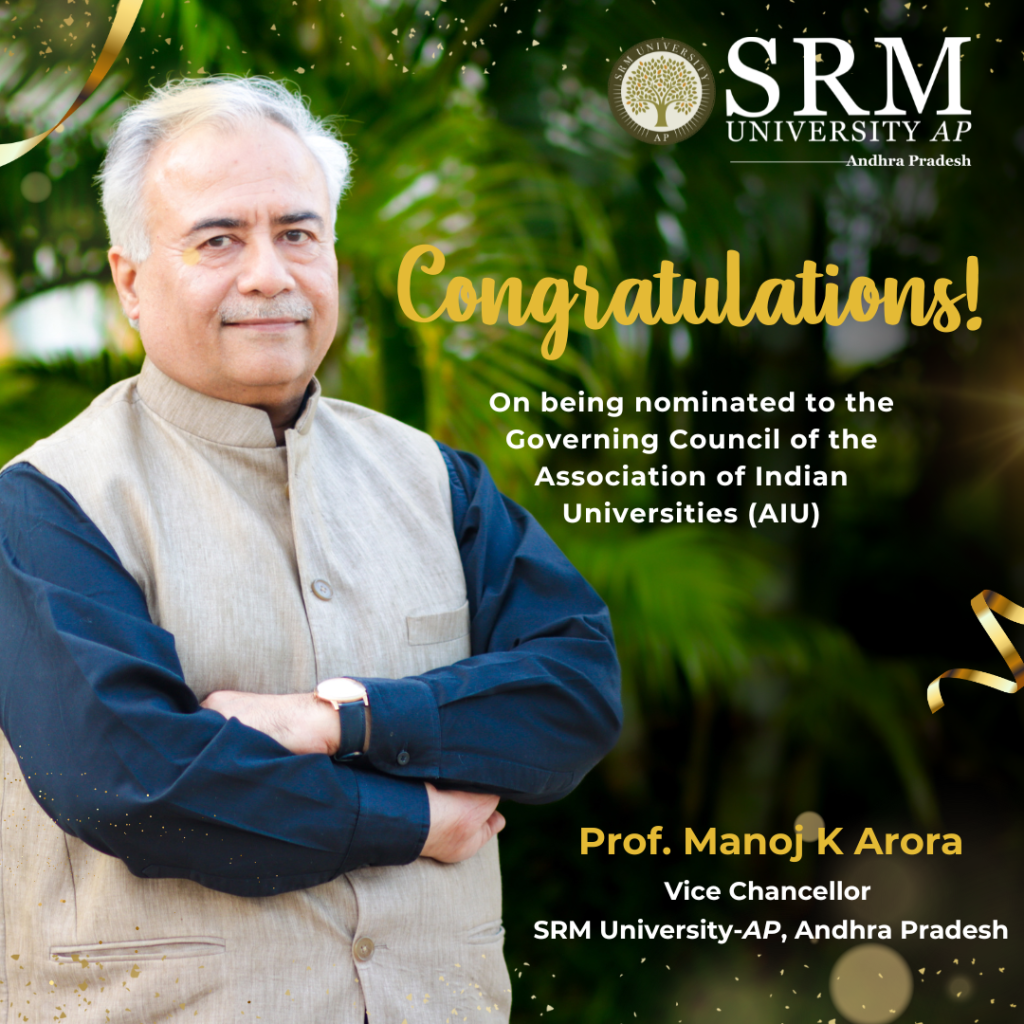 A proud moment for SRM University-AP as it announces the nomination of its esteemed Vice Chancellor, Prof. Manoj K Arora, to the Governing Council of the Association of Indian Universities (AIU). The Association of Indian Universities (AIU) serves as a paramount inter-university organisation actively involved in the advancement and nurturing of higher education.
A proud moment for SRM University-AP as it announces the nomination of its esteemed Vice Chancellor, Prof. Manoj K Arora, to the Governing Council of the Association of Indian Universities (AIU). The Association of Indian Universities (AIU) serves as a paramount inter-university organisation actively involved in the advancement and nurturing of higher education.On accepting this nomination, Prof. Arora remarked, “I am deeply humbled to have been nominated as a member of AIU and look forward to it. This nomination reflects our collective efforts towards advancing higher education and fostering collaboration, thereby working towards changing the face of higher education in India.”
This notable appointment not only recognises Prof. Arora’s outstanding contributions to the academic fraternity but also underscores SRM University-AP‘s commitment to excellence in higher education. The AIU plays a pivotal role in elevating the quality and accessibility of higher education across the nation. The AIU, with its broad membership including international institutions from Bangladesh, Bhutan, Kazakhstan, Malaysia, Mauritius, Nepal, Thailand, the UAE, and the UK, serves as a platform for global educational exchange and development. Its endeavours are directed toward creating a collaborative and innovative educational landscape, making this nomination significant for SRM University-AP and the broader academic community.
Prof. Arora’s nomination is a moment of pride not only for him but for the entire SRM AP fraternity. The university community extends its heartfelt congratulations to Prof. Arora on this noteworthy achievement and eagerly anticipates his ongoing guidance and foresight in steering the course of education in India.
Continue reading → - Innovating Human Resources: A Blockchain Technology Bibliometric Analysis July 2, 2024
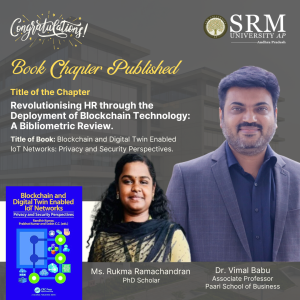 In a significant academic achievement, Dr Vimal Babu, Associate Professor at the Department of Management, Paari School of Business, and Ms Rukma Ramachandran, a PhD Scholar, have co-authored a book chapter titled “Revolutionizing HR through the Deployment of Blockchain Technology: A Bibliometric Review.” The chapter is included in the book Blockchain and Digital Twin Enabled IoT Networks: Privacy and Security Perspectives, published by Routledge: A Taylor and Francis Group.
In a significant academic achievement, Dr Vimal Babu, Associate Professor at the Department of Management, Paari School of Business, and Ms Rukma Ramachandran, a PhD Scholar, have co-authored a book chapter titled “Revolutionizing HR through the Deployment of Blockchain Technology: A Bibliometric Review.” The chapter is included in the book Blockchain and Digital Twin Enabled IoT Networks: Privacy and Security Perspectives, published by Routledge: A Taylor and Francis Group.
The research work delves into the potential of blockchain technology in transforming Human Resources practices, offering a bibliometric review to shed light on the impact and future possibilities within the field.The publication adds valuable insights to the growing discourse on blockchain applications in various industries, particularly focusing on HR management. This collaborative effort between Dr Vimal Babu and Ms Rukma Ramachandran highlights their dedication to exploring innovative solutions at the intersection of technology and management. Their contribution to the book aims to contribute to the ongoing dialogue on privacy, security, and efficiency in IoT networks, with blockchain technology playing a pivotal role in shaping the digital landscape.
The chapter’s publication signifies a notable milestone in the academic pursuits of both scholars, solidifying their expertise and thought leadership in the realm of blockchain technology and its implications for HR practices. Their contribution is expected to resonate with professionals, researchers, and students interested in the evolving dynamics of digital innovation and its impact on organisational processes.Brief Introduction of the Book Chapter
The adoption and implementation of Blockchain in Management have been gaining increasing attention. The rise in the number of studies on Blockchain in managerial applications invites a greater number of research contributions in this field. This chapter describes the gap in the present studies using a hybrid review system through the means of systematic literature review and bibliometric analysis.Publication details (incl. Publisher, ISBN, Launch date, Edition, etc)
Publisher- Taylor & Francis
ISBN- 9781003403791
Launch date- 19 July 2024
Edition- 1stTarget Audience of the Book Chapter
This book emphasizes and facilitates a greater understanding of various data security privacy approaches using the advances in Blockchain and data analysis using machine/deep learning, federated learning, edge computing and the countermeasures to overcome these vulnerabilities.Link to the Book Chapter
Continue reading →
Blockchain and Digital Twin Enabled IoT Networks | Privacy and Securit (taylorfrancis.com) - Decoding Investment Perceptions in India: Dr Lakshmana Rao’s Recent Publication July 1, 2024
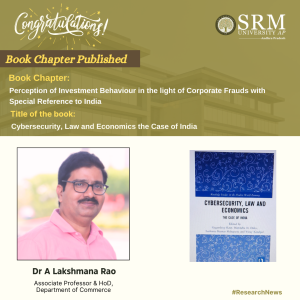 In a significant contribution to the academic discourse on corporate frauds and investment behaviour, Dr A Lakshmana Rao, Head of the Department and Associate Professor in the Department of Commerce, has published an insightful book chapter titled “Perception of Investment Behaviour in the Light of Corporate Frauds with Special Reference to India,” the chapter is a part of the book “Cybersecurity, Law and Economics: The Case of India,” published by Routledge, a prestigious Taylor and Francis Group.
In a significant contribution to the academic discourse on corporate frauds and investment behaviour, Dr A Lakshmana Rao, Head of the Department and Associate Professor in the Department of Commerce, has published an insightful book chapter titled “Perception of Investment Behaviour in the Light of Corporate Frauds with Special Reference to India,” the chapter is a part of the book “Cybersecurity, Law and Economics: The Case of India,” published by Routledge, a prestigious Taylor and Francis Group.
Dr Rao’s work delves into the intricate dynamics of investor psychology and market trust, particularly in the aftermath of corporate scandals. His research provides a nuanced understanding of how investors navigate the complex landscape of financial decision-making when confronted with corporate malfeasance.The chapter is poised to serve as a valuable resource for students, academics, and professionals interested in the intersections of finance, law, and cybersecurity. It also underscores the importance of robust legal frameworks and transparent corporate governance in maintaining investor confidence in the Indian market. With this publication, Dr Rao has made a notable contribution to the literature on economic security and investment strategies, offering a timely examination of the challenges and considerations unique to the Indian context.
A Brief Introduction of the Book Chapter
This book examines the intersection between cybersecurity and India’s law and economy and offers a course of action for designing efficacious policies against emerging cybercrimes in the country.
It reviews the boom in infrastructure growth in India and the security challenges this presents to the domestic economy and legal system. Contributors conduct a risk assessment of the potential economic impacts and security vulnerabilities, as well as identify the current regulatory and legal gaps regarding cryptocurrency, e-commerce and digital banking. The book also considers the subject of data localisation and sovereignty, and the challenges of establishing an indigenous data architecture. By discussing the economic impact of cybersecurity and incorporating recommendations from scholars, activists, academics, young legal intellectuals, and professionals in the field, the chapters propose new measures and protections for lawmakers and policymakers to adopt.Significance of the Book Chapter
The book chapter titled “Perception of Investment Behaviour in the Light of Corporate Frauds with Special Reference to India” is a survey-based study that examines the general investor’s intentions regarding their investment behaviour in various investment options and their behavioural changes in the case of corporate frauds.
Co-authors of the Book Chapter
Two co-authors, Dr G Ramakrishnan and Dr Nikhil Kulshrestha, helped conduct the research and survey.
Link to the Book Chapter publication
Publication Details (incl. Publisher, ISBN, Launch date, Edition, etc)
Continue reading →
ISBN 9781032852454
232 Pages 8 B/W Illustrations
October 1, 2024, by Routledge
Price: £ 135 - Innovative Aquaculture Monitoring System Patented by Dr K A Sunitha and Team June 27, 2024
 In a significant advancement for aquaculture technology, Dr K A Sunitha, Associate Professor in the Department of Electronics and Communication Engineering, along with her B.Tech ECE students Ms B Harshitha and Mr B Taraka Rameswara Kanaka Durga Prasad, have made headlines with their latest invention. The team has successfully filed and published a patent for “A Fully Automated System for Real-Time Monitoring of Aquaculture Environment and a Method Thereof.” The application number 202441034671, has been officially recorded in the Patent Office Journal, marking a milestone for the team and the institution they represent.
In a significant advancement for aquaculture technology, Dr K A Sunitha, Associate Professor in the Department of Electronics and Communication Engineering, along with her B.Tech ECE students Ms B Harshitha and Mr B Taraka Rameswara Kanaka Durga Prasad, have made headlines with their latest invention. The team has successfully filed and published a patent for “A Fully Automated System for Real-Time Monitoring of Aquaculture Environment and a Method Thereof.” The application number 202441034671, has been officially recorded in the Patent Office Journal, marking a milestone for the team and the institution they represent.
This pioneering system promises to revolutionise the way aquaculture environments are monitored by leveraging automation to ensure real-time, accurate assessments. The invention stands as a testament to the innovative spirit and dedication of Dr Sunitha and her students, who are now recognised as contributors to the technological advancements in the field of aquaculture.Abstract
This project involves the design and development of an Automated water quality analysis system to assist aquaculture farmers. The proposed system is tailored for aquatic environments, particularly ponds to monitor crucial parameters say Dissolved Oxygen (DO), PH, Temperature and Humidity levels, signaling when concentrations drop below the predefined threshold set by the user every thirty minutes. The system features autonomous activation and deactivation of aerators to ensure continual oxygenation of water and aids in energy optimisation. Utilising advanced sensors and a microcontroller, the device offers continuous monitoring of parameters to facilitate pond operators with timely insights into water quality dynamics, enabling proactive interventions to protect aquatic ecosystems.
Brief Explanation of the Project
India is the second-largest aquaculture nation in the world, and this sector provides livelihood support to about 280 lakh people. The aquaculture industry globally faces numerous challenges, such as Viral, bacterial, and fungal diseases and Suboptimal water quality. One crucial criterion for evaluating the quality of water is measuring the Dissolved Oxygen level. Water and other liquids contain free, non-compound oxygen, which is measured as dissolved oxygen (DO).
Long-term exposure to low DO levels increases stress and infections and, in certain situations, causes the death of the organism because dissolved oxygen is essential for the health and reproduction of many fish and invertebrates. This project highlights the design of a timer based automated water quality analysis system which can be used in the inland aquaculture farms to continuously monitor the water parameters and automate the calibration process and the operation of aerators without human intervention.
Practical Implications of the Research
The main objectives of this research are
1) To monitor the parameters, say Dissolved Oxygen, PH, Temperature and Humidity levels
every thirty minutes.
2) To automate the Calibration process to maintain accuracy and reliability of the system.
3) To automatically turn ON/OFF the aerators in the event of Low/High oxygen levels detection in the pond.
4) To send notifications to the technician or farmer every thirty minutes to help them monitor.Future Research Plans
The developed prototype is currently validated with standard DO meter during experimental trials. Moving forward, further research and development efforts may focus on refining the system’s functionality, expanding its sensor capabilities, and integrating advanced analytics for predictive monitoring and decision support, thereby advancing the state-of-the-art in aquaculture management technology and promoting the long-term viability of inland aquaculture operations.
Pictures Related to Research
Continue reading →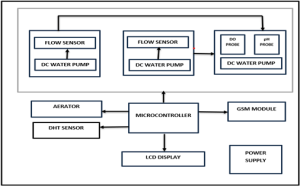
- International Yoga Day Observance: A Reflection of Tradition and Modern Wellness June 26, 2024
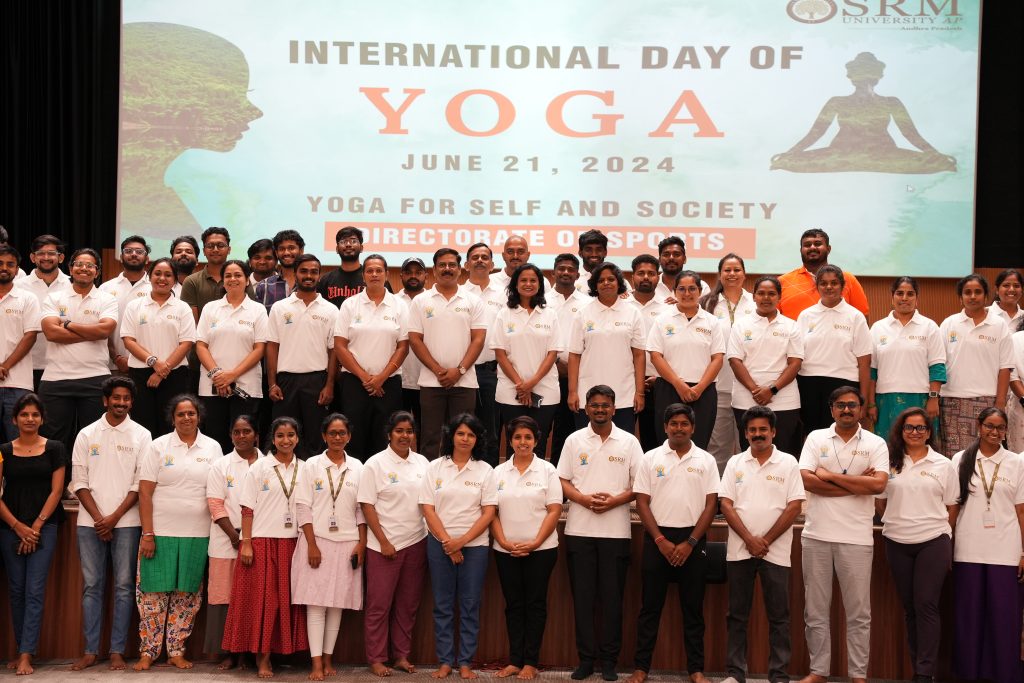
On June 21, SRM University-AP marked International Yoga Day with commendable enthusiasm, drawing the active participation of faculty, students, and staff. This significant event, organised under the auspices of the Directorate of Student Affairs and the Directorate of Sports, not only highlighted the importance of yoga in contemporary life but also emphasised the unifying power of this ancient practice.
The ceremony commenced with a warm welcome address by Mr Anil Kumar Nigam, Director of Student Affairs, setting a positive tone for the day. Mr Nigam further remarked on the profound significance of International Yoga Day, he stated, “Yoga empowers individuals to take charge of their own well-being and enables them to stand strong in the face of adversities”
The celebrations featured a captivating demonstration of traditional yoga led by the yoga instructor, Ms Moni, followed by partner yoga and collective sessions involving faculty, staff, and students. These activities showcased not just the flexibility of the participants but also underscored the principle of unity between mind, body, and soul, fostering a sense of inner peace.
Registrar, Dr R Premkumar, in his address, imparted a poignant message on the essence of self-commitment as the foundation for any path one chooses to follow. He further remarked that “Yoga’s role in bringing about the well-being of oneself and society is profound,” underscoring the transformative power of yoga in achieving personal health and inner peace.
The event not only celebrated the timeless values of peace and harmony inherent in yoga but also reinforced the varsity’s commitment to fostering a holistic educational environment. Ms Sushmita Kumari, Assistant Director of Sports, expressed her heartfelt appreciation for the enthusiastic participation of all attendees and encouraged everyone to continue on their transformative journey of wellness and harmony.
Continue reading →